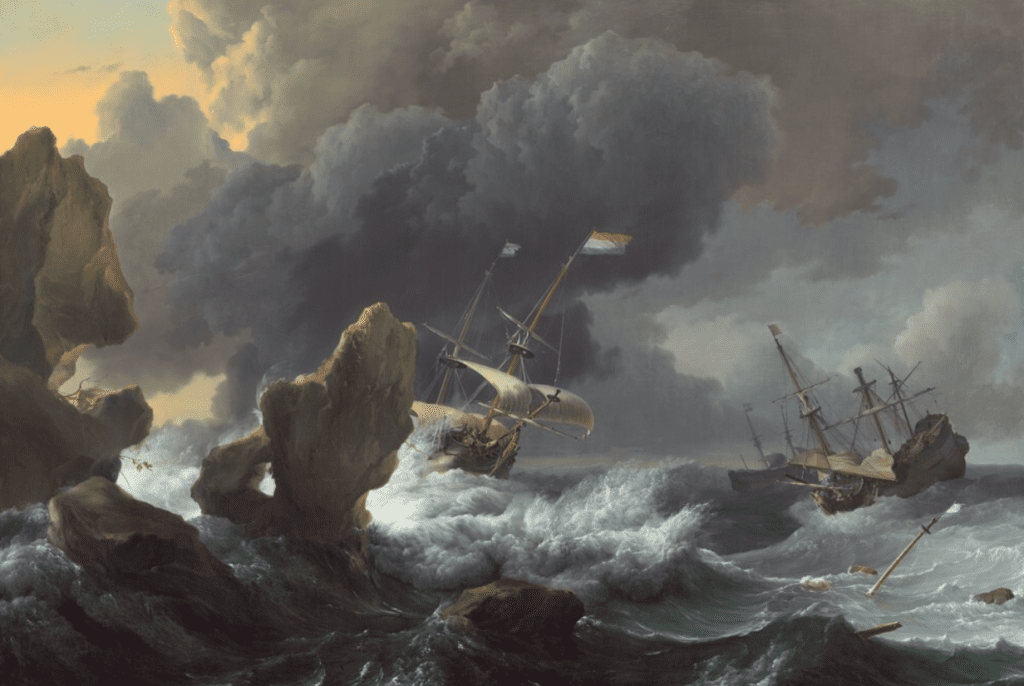 On the night of March 8, 1657, as a Nor’easter raged, a Dutch ship, The Prince Maurice slammed into the coast of Fire Island. Aboard were about 129 souls – passengers, crew and Dutch West India Company soldiers.
On the night of March 8, 1657, as a Nor’easter raged, a Dutch ship, The Prince Maurice slammed into the coast of Fire Island. Aboard were about 129 souls – passengers, crew and Dutch West India Company soldiers.
Ashore were Indigenous people on their coastal night watch, listening to the ship crash against the shoal.
When the Dutch West India Company sent the du Prince Maurits, to the new world in 1656, Gerritt van Swearingen was appointed as Super-Cargo of the vessel (an officer of a merchant ship whose duty is to manage the commercial concerns of the voyage).
Jacob Alrichs, Marten Crieger, and Alexander d’Hinojossa, who would lead the colony, were also on board as The Prince Maurice sailed from the port of Amsterdam, Holland December 21, 1656, and then went to Texel, where the final departure was on Christmas Day, 1656. The ship was carrying gunpowder, tiles, and supplies to the Dutch colony of New Amstel, located on the Delaware River, along with the immigrants.
The Prince Maurice may have been a fluyt (flute), designed to provide maximum space for cargo and passengers and a smaller crew. These ships could carry twice the cargo of the ships commonly used at the time, and gave the Dutch a tremendous trading advantage.
These ships typically weighed 200–300 tons and were approximately 65-80 feet in length and was somewhat similar to the Spanish galleon.
The standard fluyt design minimized or completely eliminated its armaments to maximize available cargo space, and used block and tackle extensively to facilitate ship operations. Another advantage of its pear-shape (when viewed from the fore or aft) was a shallow draft which allowed the vessel to bring cargo in and out of ports and up and down rivers which other vessels could not reach.
On the night of March 8, 1657 the ship grounded off Fire Island, near the coast of Long Island. The crew and passengers got to shore the next day. They were without fire for two days in freezing weather.
On the third day friendly Indigenous people who were employed as messengers by the Dutch West India Company arrived and carried word to Governor Peter Stuyvesant at New Amsterdam.
Stuyvesant arrived in a sloop, taking some passengers to New Amsterdam, where they remained several weeks and part of the cargo was salvaged before the ship broke-up on the rocks.
At New Amsterdam another ship, Beaver, was chartered, and those of the Prince Maurice sailed from there on April 16, 1657.
They arrived at “South River” (Delaware River) settlement on April 21, 1657, where they landed and took possession of the Fort on April 25, 1657, and established the town of New Amstel (now New Castle, Delaware).
You can read more details about the story here. Read more about shipwrecks in New York here.
Upcoming Event
The New Amsterdam History Center’s Mapping Early New York project uncovered correspondence, ship manifests, and maps to pinpoint the shipwreck, and tell the story of the rescue on an ice laden beach.
They will present an illustrated talk, including 3D modeling, at Southampton History Museum, in Southampton, NY, on Saturday, May 18th, from 11 am until 12:30 pm.
“This project follows in the footsteps of our recent 3D Model created for the New-York Historical Society’s installation New York Before New York: The Castello Plan, on view March 15 – July 14, 2024,” said Esme E. Berg, Executive Director of the New Amsterdam History Center. “Later in June, the presentations also be available online.”
Richly illustrated with 3D models, interactive maps, and documents, a one-hour talk with Q & A session to follow, presenters include Mapping Early NY Project Director Toya Dubin, and Algonkian historical consultant Drew Shuptar-Rayvis.
Tickets are free of charge, but RSVPs are required here.
Illustration: “Ships in Distress off a Rocky Coast” by Ludolf Backhuysen, 1667 (National Gallery of Art).


